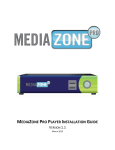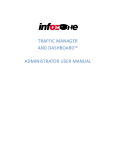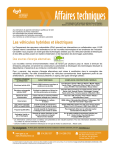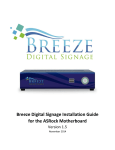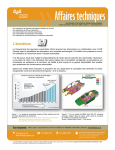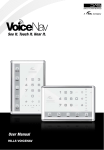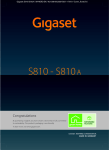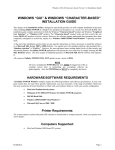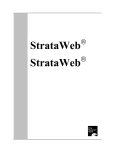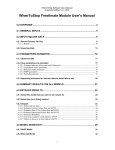Download InfoZone User Manual.. - Keywest Support
Transcript
TRAFFIC MANAGER AND DASHBOARD™ USER MANUAL TABLE OF CONTENTS DASHBOARD Introduction ........................................................................................................................................................................... 4 Key Features ....................................................................................................................................................................... 4 System Requirements ........................................................................................................................................................ 4 Interface ................................................................................................................................................................................. 5 The Dashboard Page – Admin User .................................................................................................................................... 6 Player Cells ......................................................................................................................................................................... 9 The Dashboard Page – User with Local Zone Control ...................................................................................................... 10 The Playlist Summary Page .............................................................................................................................................. 11 The Playlist Editor Page .................................................................................................................................................... 12 The Create Additional Media Pages ................................................................................................................................. 15 The Activate Playlist Page................................................................................................................................................. 18 The Edit Crawl Page .......................................................................................................................................................... 19 The EAS Events Page - Description ................................................................................................................................... 20 The EAS Events Page – Standard User .............................................................................................................................. 21 The EAS Results Page ....................................................................................................................................................... 24 The Monitor Control Page ................................................................................................................................................ 25 Troubleshooting ................................................................................................................................................................... 29 Copyright © 2010 Keywest Technology, Inc. All Rights Reserved 14563 W 96th Terrace • Lenexa KS 66215 USA • Need Support? Mailto:[email protected] 2 TABLE OF CONTENTS TRAFFIC MANAGER SCHEDULER Introduction ................................................................................................................................................................ 31 Key Features ............................................................................................................................................................ 31 System Requirements ............................................................................................................................................. 31 Interface ...................................................................................................................................................................... 32 Main Window .......................................................................................................................................................... 32 The Schedules Pane ................................................................................................................................................. 34 The Tree View Pane ................................................................................................................................................. 35 Status Area Pane ..................................................................................................................................................... 35 Using Traffic Manager Scheduler ................................................................................................................................ 36 Performing An Update ............................................................................................................................................ 38 Create New Schedule .............................................................................................................................................. 39 Edit Schedule ........................................................................................................................................................... 41 Support Files ............................................................................................................................................................ 41 Troubleshooting .......................................................................................................................................................... 42 Copyright © 2010 Keywest Technology, Inc. All Rights Reserved 14563 W 96th Terrace • Lenexa KS 66215 USA • Need Support? Mailto:[email protected] 3 INTRODUCTION Thank you for purchasing InfoZone Server. You can now take advantage of this powerful software suite to manage the content of your network of digital signage displays. Traffic Manager Dashboard plays an essential role within InfoZone Server, as it provides a front-end interface for monitoring and updating content displayed on the digital signage. Please be sure to read through this manual carefully to get the most out of Traffic Manager Dashboard. KEY FEATURES Web-based application allows monitoring of InfoZone Server from any browser Performs user authentication upon login to deliver user- dependent content Company logos and branding can be incorporated into pages Offers interoperability with Traffic Manager Server and InfoZone Player Includes Local Zone Control, to allow local users to add their own signage content SYSTEM REQUIREMENTS Although Traffic Manager Dashboard was optimized for Internet Explorer 8, it is cross-browser compatible with nearly every popular browser for PC or hand-held device. Some pages may produce layout variations when using browsers other than Internet Explorer 8. Copyright © 2010 Keywest Technology, Inc. All Rights Reserved 14563 W 96th Terrace • Lenexa KS 66215 USA • Need Support? Mailto:[email protected] 4 INTERFACE The following sections describe the Traffic Manager Dashboard interface, page by page. When the application is launched, a browser window will open the login page, as shown below. To successfully log in, the username and password fields must match those assigned by the system administrator via the Traffic Manager Server application. Different users can have different privileges, such as the number of players they can view, local zone control or EAS access. The next section describes the admin user, who can view all players in a network. Copyright © 2010 Keywest Technology, Inc. All Rights Reserved 14563 W 96th Terrace • Lenexa KS 66215 USA • Need Support? Mailto:[email protected] 5 THE DASHBOARD PAGE – ADMIN USER The dashboard page is the main interface for the Traffic Manager Dashboard software. It provides an overview of the entire network, with key information about each player, including a screen capture of the digital sign. The admin user, by default, can view all players in a network, as shown below in this sample network. Other users, as described later, may view only a subset of the players. The Dashboard table of player cells automatically refreshes every 30 seconds to display updated player thumbnail images and data. There is therefore no need to refresh the browser window. Copyright © 2010 Keywest Technology, Inc. All Rights Reserved 14563 W 96th Terrace • Lenexa KS 66215 USA • Need Support? Mailto:[email protected] 6 1. 2. 3. 4. 5. Header Logo This area displays an image, such as a company logo, on all pages of Traffic Manager Dashboard. Customizing this logo is discussed later in this user manual. Menus These three menus allow the user to adjust the player cells. Each menu is discussed in further detail on the following page. Player Cells This area displays a table of player cells, each containing player information and a thumbnail preview of content displayed on the digital sign. The number of player cells in each horizontal row is based on the width of the browser, so resizing the browser window will cause the player cells to wrap for a better fit. Quick Links Each page of Traffic Manager Dashboard includes a Logout button, and a hyperlink to the Dashboard page. Welcome Tag The welcome tag identifies your current login name. Copyright © 2010 Keywest Technology, Inc. All Rights Reserved 14563 W 96th Terrace • Lenexa KS 66215 USA • Need Support? Mailto:[email protected] 7 The three Dashboard menus are used to adjust how player cell information is displayed. The currently active menu item is shown as bold. To display the menu items, hover your mouse over the menu title. Click to select a menu item. 1. 2. 3. Thumbnails This menu controls the size of the thumbnails, or none at all. Show/Hide Players These menu items are used to set which players are shown in the table, depending on their status. Sort Players This menu controls the sorting of the player cells. The Default setting is the basic network structure as defined in Traffic Manager Server. Both the Division and Name menu items use an alphabetical sort, while the Check-In Time menu item sorts the player cells from the oldest check-in time to the most recent. Copyright © 2010 Keywest Technology, Inc. All Rights Reserved 14563 W 96th Terrace • Lenexa KS 66215 USA • Need Support? Mailto:[email protected] 8 PLAYER CELLS Each player in the Traffic Manager network is shown as an individual cell in Dashboard, to provide detailed information about the player. Placing your cursor over the thumbnail highlights the cell and displays a tooltip with the player name, as shown below. The information in the player cell includes the following: Name: the name of the player IP: the IP address of the player, as reported by InfoZone Player Schedule: the current schedule that is being played on the player Division: the division to which the player belongs, or the server name if no division exists Product: the name of the MediaZone software product that the player is using Check-in: the date and time that the thumbnail image file was last uploaded from the player Status: the current status of the player, either Good, Error, Update in Progress, or Disabled The information text of each player cell can vary in color depending on its status; red for error, blue for update in progress, grey for disabled, or normal for good. In addition to the status text, an indicator light appears in the lower right corner of the player cell. Status Good Disabled Update in Progress Error Description Player has recently checked in Player is currently set as disabled Player is downloading an update Player is incommunicado Indicator Light Copyright © 2010 Keywest Technology, Inc. All Rights Reserved 14563 W 96th Terrace • Lenexa KS 66215 USA • Need Support? Mailto:[email protected] 9 THE DASHBOARD PAGE – USER WITH LOCAL ZONE CONTROL This section describes the Dashboard interface for a user who has access to two players, including local zone control of both. When this user moves the cursor over a player cell, the cell becomes highlighted and a tooltip displays “Click to edit playlist”, as shown below. Clicking this directs the user to the Playlist Summary page. Copyright © 2010 Keywest Technology, Inc. All Rights Reserved 14563 W 96th Terrace • Lenexa KS 66215 USA • Need Support? Mailto:[email protected] 10 THE PLAYLIST SUMMARY PAGE The playlist summary page is the “start” page for managing local zone control. Note: users who only have access to one player, and who have local zone control permissions, will go directly to the playlist summary page after logging in, bypassing the Dashboard page. A “playlist” is a set of images or videos selected by the user to appear in a pre-defined area, or zone, on the digital sign. Because the custom content is controlled by a user who is typically near in proximity to the player, the term “local zone control” is used throughout this document. The playlist summary page includes a table of all playlists for the player, displayed as cells. Within the cell is a thumbnail of the first image in the playlist, an Edit Playlist button and an Edit Crawl button. If a playlist is empty, an Awaiting Thumbnail Image message will appear in the playlist cell in lieu of the first image. Note: a player can have only one playlist. However, future versions of Traffic Manager Dashboard may include multi-playlist functionality. An activate label is also present, which redirects the user to a confirmation page. To “activate” is to begin playing the playlist in a local zone on the digital sign. The Edit Playlist button redirects the user to the Playlist Editor page, which is used to create or modify a playlist. Copyright © 2010 Keywest Technology, Inc. All Rights Reserved 14563 W 96th Terrace • Lenexa KS 66215 USA • Need Support? Mailto:[email protected] 11 THE PLAYLIST EDITOR PAGE The Playlist Editor page provides the tools needed to create and manage custom content for a local zone. 1. 2. 3. 4. 5. 6. 7. 8. 9. Site Navigator This control provides links to navigate to the different pages of local zone control, and is found throughout the local zone control pages. Available Media Files This lists all media files available for use in a playlist. Create Additional Media Link This links to the pages used to create additional media files, as discussed later in this manual. File Upload Controls These ten controls are used to add to the list of available media files. A browse button is provided to navigate the local file system. Upload Button This button will upload all files listed in the file upload controls. Add, Remove, Delete, and Reload Media Buttons The Add and Remove buttons are used to move files to and from the Available Media Files list and the Playlist Files list. The Delete button will permanently remove an available media file. The Reload Media button refreshes the list of available media files. Playlist Files This lists all media files in the playlist. Move Up/Down Controls These controls are used to rearrange the order of the playlist files Media Attributes Copyright © 2010 Keywest Technology, Inc. All Rights Reserved 14563 W 96th Terrace • Lenexa KS 66215 USA • Need Support? Mailto:[email protected] 12 This area is used to define the attributes of the media files in the playlist. See the Using Playlist Editor section of this manual for further information. 10. Thumbnail Preview This control will display a thumbnail image of the currently selected image file. Click to enlarge the image. Video files cannot be displayed as a thumbnail, but can be previewed by clicking. 11. Save Playlist This button saves the playlist and redirects the user to the Activate page. To add content to a playlist, media files must first be uploaded to the server. This can be done by entering filenames from a local drive in the file upload control textbox, or by pressing the Browse button to navigate to the location of the media file(s). Once the desired files have been specified, the files can be added by pressing the Upload button. The files will be uploaded to the server shortly, depending on the connection speed and the size and number of files. When the upload is complete, they will appear in the Available Media Files list. Selecting a file displays a thumbnail preview, as shown below. Copyright © 2010 Keywest Technology, Inc. All Rights Reserved 14563 W 96th Terrace • Lenexa KS 66215 USA • Need Support? Mailto:[email protected] 13 Pressing the Add button will add the highlighted media files on the left to the playlist on the right. Pressing the Remove button will remove highlighted files from the playlist on the right. Multiple files can be added and removed by using the standard Windows method of holding the Shift key on the keyboard while selecting with the mouse. Reorder media in the playlist by selecting files and pressing the Move up or Move down buttons. See a larger version of the selected image by clicking the thumbnail. A separate browser window will appear. Permanently delete a file from the list of available media files by selecting it and pressing the Delete button. Only files that are not currently used in the playlist can be deleted. The Media Attributes area is just beneath the Playlist Files list, and is used to define key attributes (properties) of the file, such as when to display it and for how long, as shown to the right. In this example, the Desert.jpg will be displayed all the time, and will appear for 10 seconds. Selecting the Specific Dates option defines the start/end dates and start/end times, as well as specific days of the week. Copyright © 2010 Keywest Technology, Inc. All Rights Reserved 14563 W 96th Terrace • Lenexa KS 66215 USA • Need Support? Mailto:[email protected] 14 Pressing Save Attributes after making a change is required. Multiple files attributes can be changed at once by selecting more than one file in the playlist files list. THE CREATE ADDITIONAL MEDIA PAGES Selecting the Create Additional Media File from Template link allows the user to create a custom media file, complete with text and graphics. The Media Editor page presents several templates to choose from when creating a media file. The thumbnails provide a preview of the layout for each template, including text groupings and picture placement, as shown below. Selecting a template directs the user to the Edit Media page. Copyright © 2010 Keywest Technology, Inc. All Rights Reserved 14563 W 96th Terrace • Lenexa KS 66215 USA • Need Support? Mailto:[email protected] 15 The Edit Media page is divided into multiple sections, depending on the template chosen on the previous page. The example below is based on a template with one text field. All templates include a section for specifying the background, which can consist of a color, a pre-defined image, or a custom uploaded image. 1. 2. 3. Background This area is used to define the background of the media file. Choose from a color, a stock image, or upload a custom image. Text This area defines the text content and its formatting. Enter the desired text in the textbox, and then select the font, size, color, location, and other formatting options for the text. Filename Copyright © 2010 Keywest Technology, Inc. All Rights Reserved 14563 W 96th Terrace • Lenexa KS 66215 USA • Need Support? Mailto:[email protected] 16 4. This area defines the filename for the media file. Choose a descriptive filename to easily identify it later. Save Image Button This button is used to save the media file. After pressing this button, the user is redirected to the Playlist Editor page, where the new image appears in the Available Media Files list, as shown below. Copyright © 2010 Keywest Technology, Inc. All Rights Reserved 14563 W 96th Terrace • Lenexa KS 66215 USA • Need Support? Mailto:[email protected] 17 THE ACTIVATE PLAYLIST PAGE Pressing the Save Playlist button when finished editing will save the playlist and redirect the browser to the Playlist Manager page, where a confirmation page prompts to activate the playlist. Activating a playlist will queue an update for the player the next time it checks in. The playlist will then be deployed to the player and soon appear in the local zone of the digital sign. Pressing Cancel will redirect the browser back to the Playlist Editor page. Pressing OK will redirect the browser to the Playlist Summary page. Copyright © 2010 Keywest Technology, Inc. All Rights Reserved 14563 W 96th Terrace • Lenexa KS 66215 USA • Need Support? Mailto:[email protected] 18 THE EDIT CRAWL PAGE The Playlist Summary page also contains an Edit Crawl button to create a custom crawl, as shown below. A crawl is a text-based message that scrolls horizontally along the bottom of the digital sign, without interrupting the normal content. Crawls are typically used for timely messages and alerts. Pressing the Edit Crawl button directs the browser to the Edit Crawl page, as shown below. 1. Save This button is used to save the current crawl text to a file, which is then used by the MediaZone Player software for displaying a crawl on the digital sign. Once saved, the text will be retained and the next visit to the Edit Crawl page will display the crawl text within the crawl text box (item 3 shown above). 2. Global The global control, when set to on, will use the same crawl message on every player that the user has permissions for. This saves time duplicating the same crawl text for multiple players. Copyright © 2010 Keywest Technology, Inc. All Rights Reserved 14563 W 96th Terrace • Lenexa KS 66215 USA • Need Support? Mailto:[email protected] 19 3. 4. Crawl Textbox This textbox is used for inputting the crawl text. Clicking inside this textbox enables a message to be input. Pressing the Enter key will cause a new line to appear. When the crawl text is displayed on the digital sign, each new line of text will be separated from the previous line by several spaces. To place a separator in the crawl text, type a special character such as a vertical bar (|) or an asterisk (*). A crawl can be removed from a digital sign by deleting the crawl text from this box and pressing Save. Help This button, when pressed, is used to display a hidden pane with helpful FAQs. It can be collapsed, as well. Note: in order for a digital sign to display a crawl, the schedule of the player must include a crawl layer, and the schedule itself must not contain its own crawl text. Saving a crawl message may take minutes to appear on the digital sign. If it fails to appear after a reasonable wait, contact the system administrator. THE EAS EVENTS PAGE - DESCRIPTION The following sections describe the Emergency Alert System (EAS) functionality, which is used to send alert messages to players in time of emergency. Users are granted access to these pages via the Traffic Manager Server application, Admin tab. A standard user who has EAS access is sent directly to the EAS Events page after initially logging into Traffic Manager Dashboard. Once at this page, the user can send two types of emergency alerts: an Instant Crawl alert or a Full Screen alert. The EAS Events page is divided into two panels for sending both of these types of alerts, as described in the next section. In addition to the standard user who has access to EAS, there is a special classification of an EAS user, the EAS administrator. This user is responsible for configuration of the alert messages and therefore has access to two other panels on the EAS Events page with additional features. Any user (or users) can be deemed the EAS administrator in one of two ways: through the Traffic Manager Server application Admin tab or through the Traffic Manager Dashboard User Account page (see the User Account Page section of this document). Furthermore, a user can be deemed both an administrator and an EAS administrator, if desired. Copyright © 2010 Keywest Technology, Inc. All Rights Reserved 14563 W 96th Terrace • Lenexa KS 66215 USA • Need Support? Mailto:[email protected] 20 THE EAS EVENTS PAGE – STANDARD USER The EAS Events page for a standard user Copyright © 2010 Keywest Technology, Inc. All Rights Reserved 14563 W 96th Terrace • Lenexa KS 66215 USA • Need Support? Mailto:[email protected] 21 The Instant Crawl panel 1. Recipients This textbox determines which players will receive the instant crawl alert. Clicking inside the Recipients textbox reveals a treeview of all players, with checkboxes next to each, as shown below. 2. Crawl Text This textbox is used for inputting the crawl text. There is a maximum 800 character limit. Dwell Minutes This textbox is used to set the number of minutes that the Instant Crawl alert shall last. The minutes can be typed directly into this textbox, or incrementally adjusted with the up and down arrow buttons. Crawl Position This drop-down box allows the user to specify the vertical location of the crawl: top, center or bottom. Send and Stop Buttons These buttons communicate with Traffic Manager Server to send or stop the alert to the players. Once pressed, the buttons are hidden and a “Please wait” message appears so the user cannot continue to press the buttons. The browser is then redirected to the EAS Results page. 3. 4. 5. Copyright © 2010 Keywest Technology, Inc. All Rights Reserved 14563 W 96th Terrace • Lenexa KS 66215 USA • Need Support? Mailto:[email protected] 22 The Full Screen Alert panel 1. 2. 3. 4. 5. 6. Recipients This textbox determines which players will receive the full screen alert. Clicking inside the Recipients textbox reveals a treeview of all players, with checkboxes next to each, as described on the previous page. Available Full Screen Alerts This area displays all available full screen alert images with titles, as configured by the EAS administrator. Optional EAS Text This textbox is used to enter additional text to appear with the full screen alert image. The EAS administrator predetermines the formatting and location of the optional text for each image. Dwell Minutes This textbox is used to set the number of minutes that the Instant Crawl alert shall last. The minutes can be typed directly into this textbox, or incrementally adjusted with the up and down arrow buttons. Preview Button This button is used to produce a larger view of the full screen alert image, with the optional text. Send and Stop Buttons These buttons communicate with Traffic Manager Server to send or stop the alert to the players. Once pressed, the buttons are hidden and a “Please wait” message appears so the user cannot continue to press the buttons. The browser is then redirected to the EAS Results page. Copyright © 2010 Keywest Technology, Inc. All Rights Reserved 14563 W 96th Terrace • Lenexa KS 66215 USA • Need Support? Mailto:[email protected] 23 THE EAS RESULTS PAGE Sending an alert from the EAS Events page communicates directly with Traffic Manager Server to issue the alert to the players, and then automatically redirects the user to the EAS Results page, as shown below. 1. 2. 3. 4. Alert Status The Alert Status label informs the user of the type of alert and the time it was sent. Any alert that results in a failure will appear in red, with a more detailed description of the failure. Player Status This area lists all players and their success or failure to receive the alert. A player alert that results in a failure will post this status in red, as shown above. Dashboard Button This button redirects the user to the Dashboard page, where the user can see an uploaded screen capture of the digital sign and view the alert. EAS Events Button This button redirects the user back to the EAS Events page. Copyright © 2010 Keywest Technology, Inc. All Rights Reserved 14563 W 96th Terrace • Lenexa KS 66215 USA • Need Support? Mailto:[email protected] 24 THE MONITOR CONTROL PAGE The following section describes the Monitor Control functionality, used to create and issue a schedule of serial commands which control the digital signage monitor. A typical Monitor Control schedule might include commands to power on a monitor at 8:00 AM and power off at 10:00 PM daily. Furthermore, if a monitor has been configured to accept Monitor Control commands, it automatically will be powered on in the event of an Emergency Alert. Monitor Control is available to both users who are administrators and users who have been given access to EAS functions. Copyright © 2010 Keywest Technology, Inc. All Rights Reserved 14563 W 96th Terrace • Lenexa KS 66215 USA • Need Support? Mailto:[email protected] 25 Recipients The initial view of the Monitor Control page has only one enabled control, the Recipients textbox. This textbox determines which players will receive the monitor control schedule. Clicking inside the Recipients textbox reveals a treeview of all players, with checkboxes next to each, as shown below. Once recipients have been checked and the OK button has been pressed, the names of the players will appear in the Recipients textbox and the other controls on the page will be enabled. If previously saved, the first recipient’s settings will be retrieved to populate the miscellaneous controls throughout the page. 1. 2. 3. Basic and Advanced Tabs The basic tab is used for defining a typical monitor control scenario of weekday and weekend schedules, with an optional special schedule. The advanced tab is only available to administrators. Weekday This panel is used to define the schedule to run during weekdays when the Enabled checkbox is checked. Days of Week These checkboxes allow for customizing the days of the week. Copyright © 2010 Keywest Technology, Inc. All Rights Reserved 14563 W 96th Terrace • Lenexa KS 66215 USA • Need Support? Mailto:[email protected] 26 4. Turn On and Turn Off Controls These controls define when the monitor should be turned on and off. The weekday and weekend panels are identical in design and behavior. A typical scenario would be to set the weekday schedule to run Monday – Friday and weekend schedule for Saturday – Sunday. However, the ability to select individual days allows much greater flexibility. For instance, it is feasible to define a weekday schedule as Monday, Wednesday, Friday and weekend as Tuesday, Thursday. With this built-in flexibility, the scheduling of monitor control can be as simple or complex as desired. In addition to weekday and weekend schedules, a third panel, named Special, is available for special event scheduling. An example of a special event is a holiday, as shown below. 1. 2. 3. Enabled When the Special schedule is enabled, it will override any weekday or weekend schedules. Start Date and End Date Special schedules have two additional settings for selecting the start and end dates. The dates should be entered in MM/DD/YYYY format, or by selecting a date from the calendar picker. After the end date and time has transpired, the normal weekday and weekend schedules resume. Save The save button will save the schedules. The next time a recipient player checks into Traffic Manager Server, the new schedule will be downloaded and the player will begin using the new monitor control settings. Copyright © 2010 Keywest Technology, Inc. All Rights Reserved 14563 W 96th Terrace • Lenexa KS 66215 USA • Need Support? Mailto:[email protected] 27 Advanced Tab For administrators only, the advanced tab contains a control for setting the repeat value for all monitor control commands. A repeat is often used to ensure that the digital signage monitor is kept in the desired state and can overcome tampering (for instance, if a person manually powers on a monitor when the schedule is set to power it off). Setting this value to one minute or higher will ensure that the command will be repeatedly sent to the monitor. Setting the value to zero indicates that a command will be issued once but will not repeat. 1. Repeat Control Enter a value for the repeat interval or use the up/down buttons to adjust the value. Copyright © 2010 Keywest Technology, Inc. All Rights Reserved 14563 W 96th Terrace • Lenexa KS 66215 USA • Need Support? Mailto:[email protected] 28 TROUBLESHOOTING The Dashboard page displays all players as red, even though the players are checking in. This can occur if the Traffic Manager Server application is not running. Traffic Manager Dashboard relies upon Traffic Manager Server to provide up-to-date information about the players in the network. The Dashboard page stopped displaying the network players. Although Dashboard has no built-in timeout value and refreshes automatically, a loss of connectivity or a network disruption can cause the page to stop displaying the network players. If this occurs, log out and in again to restore Dashboard to its normal state. Selecting a player cell in Dashboard does not redirect the browser to the Playlist Summary page. Only users with local zone control can access the Playlist Summary page. The system administrator can grant these permissions. After performing an operation, the Login page appears. All pages, with the exception of the Dashboard page, have a built-in timeout period that causes an automatic logout after a period of inactivity. This is normal behavior. An error not described here has occurred. For other errors, have the system administrator check the error log files to find error messages. Often these log entries can indicate the cause of an error. Copyright © 2010 Keywest Technology, Inc. All Rights Reserved 14563 W 96th Terrace • Lenexa KS 66215 USA • Need Support? Mailto:[email protected] 29 TRAFFIC MANAGER SCHEDULER™ Copyright © 2010 Keywest Technology, Inc. All Rights Reserved 14563 W 96th Terrace • Lenexa KS 66215 USA • Need Support? Mailto:[email protected] 30 INTRODUCTION Thank you for purchasing InfoZone Server. You can now take advantage of this powerful software suite to manage the content of your network of digital signage displays. Traffic Manager Scheduler plays a key role in InfoZone Server, communicating with Traffic Manager Server to schedule and update content displayed on the digital signage. Please be sure to read through this manual carefully to get the most out of Traffic Manager Scheduler. KEY FEATURES Provides a secure, password-protected connection with Traffic Manager Server Retrieves the network structure from Traffic Manager Server in real-time Includes easy to use, drag-and-drop functionality to update player schedules Provides for creation of a new schedule with either single or multiple sets Allows updating of schedules to multiple players simultaneously Permits opening of schedule file in Notepad to view contents SYSTEM REQUIREMENTS PC-compatible server, desktop or laptop with LAN or wireless network connection Windows XP, Vista, 7 Copyright © 2010 Keywest Technology, Inc. All Rights Reserved 14563 W 96th Terrace • Lenexa KS 66215 USA • Need Support? Mailto:[email protected] 31 INTERFACE The following sections describe the Traffic Manager Scheduler interface. Upon initial launch of the application, the software attempts to load the schedules folder and server address history. If no history is found, a following message will appear. Press OK to dismiss this message and display the Traffic Manager Server main window. MAIN WINDOW Copyright © 2010 Keywest Technology, Inc. All Rights Reserved 14563 W 96th Terrace • Lenexa KS 66215 USA • Need Support? Mailto:[email protected] 32 1. Standard Toolbar This standard toolbar includes the following controls: Icon Description Create new schedule button launches the Schedule Wizard Schedule folder drop-down menu indicates the location of schedule files Browse button allows selection of schedules folder via dialog Server address drop-down menu indicates the URL or IP address of the server Connect button establishes a connection with Traffic Manager Server Disconnect button terminates the connection with Traffic Manager Server Download schedules button retrieves the network structure from the server Upload schedules button sends the network structure to the server Remove selected schedule is used to remove the currently selected schedule Remove all schedules is used to remove the schedule of each network player 2. 3. 4. Schedules Pane This pane displays all schedules from the folder specified in the schedule folder drop-down. Placing the cursor over a schedule will reveal its properties. When connected to Traffic Manager Server, a schedule can be dragged and dropped onto a player shown in the tree view. Status Area Pane This area displays messages while uploading to Traffic Manager Server. Tree View Pane This pane, when connected to Traffic Manager Server, displays the network structure as a tree view. Copyright © 2010 Keywest Technology, Inc. All Rights Reserved 14563 W 96th Terrace • Lenexa KS 66215 USA • Need Support? Mailto:[email protected] 33 THE SCHEDULES PANE The schedules pane is populated with the schedule files that reside in the folder shown in the schedules drop-down box. If the schedule pane is empty, use the Browse button to locate a folder that contains schedules. In the example above, the schedules drop-down box specifies a folder, C:\Program Files (x86)\MediaZone Editor\Application\Schedules, which contains several schedule files, shown in the schedule pane. The schedule file includes a tooltip with file information, if the cursor is placed over it. Copyright © 2010 Keywest Technology, Inc. All Rights Reserved 14563 W 96th Terrace • Lenexa KS 66215 USA • Need Support? Mailto:[email protected] 34 THE TREE VIEW PANE This area displays the network structure as a tree view, once connected to Traffic Manager Server. The tree view contains icons to quickly identify the type of machine. The server itself appears as a black server, while divisions appear in grey. Players also have their own icon, as do schedules. Note: Traffic Manager Scheduler is designed to specify player schedules; it cannot be used to add, delete, rename or rearrange players. This type of network management must be performed in the Traffic Manager Server application. STATUS AREA PANE When performing an upload to Traffic Manager Server, the status area pane displays a log of events related to the file transfers, including real-time progress statistics. This area can also be used to troubleshoot errors, such as file transfer failures, file not found errors, etc. Copyright © 2010 Keywest Technology, Inc. All Rights Reserved 14563 W 96th Terrace • Lenexa KS 66215 USA • Need Support? Mailto:[email protected] 35 USING TRAFFIC MANAGER SCHEDULER The following sections describe how to use Traffic Manager Scheduler in a typical environment. For demonstration purposes, a sample Traffic Manager Server that contains a network of nine players will be used. To connect to such a network, enter a valid URL or IP address of a dedicated Traffic Manager Server and press the Connect button. A login prompt will appear. Enter the user name and password, as assigned by the administrator and saved within the Traffic Manager Server application. Once authenticated, Traffic Manager Scheduler will display the network structure in the tree view pane, as shown below. Notice the Connect toolbar button has changed to a Disconnect button, and the other toolbar buttons have been enabled. Also note that a help panel appears above the list of schedules. This panel includes a tip to inform the user to use drag-and-drop to change a player schedule. It can be closed by selecting the X in the upper-right corner of the panel. Copyright © 2010 Keywest Technology, Inc. All Rights Reserved 14563 W 96th Terrace • Lenexa KS 66215 USA • Need Support? Mailto:[email protected] 36 Note: dropping a schedule on the player name may require some practice. A helpful tip is to align the center of the arrow cursor over the desired player name, as shown below. When a schedule has been dropped on a player, it becomes highlighted in green. This indicates that the player is queued for an update after uploading to Traffic Manager Server. To undo, either right click the schedule and uncheck Update, or use the Download button to retrieve the network from Traffic Manager Server again. A player can also be queued for an update without dropping a schedule on top of it. If the player requires an update without changing its schedule, right-click the player and select Update, as shown below. The Update Similar Schedules item will queue all players which use this schedule for an update. This feature is also found when right-clicking a schedule file in the left schedules pane. Right-clicking the server name, or a division, reveals another menu item, Update Sub Schedules. Selecting this item will highlight the schedules of all players beneath, queuing them for an update. The schedule files listed in the left schedules pane also have an associated right-click menu, as shown below. Selecting Edit launches the Edit Schedule dialog, discussed later in this document. Open in Notepad is used for viewing and editing the schedule file in a text editor. Update Similar Schedules will highlight all occurrences of this schedule in the tree view pane, queuing them for an update. Copyright © 2010 Keywest Technology, Inc. All Rights Reserved 14563 W 96th Terrace • Lenexa KS 66215 USA • Need Support? Mailto:[email protected] 37 PERFORMING AN UPDATE Once the desired players have been queued for an update with highlighted schedules, press the Upload button to send to Traffic Manager Server. Only those players with highlighted schedules will perform an update; all others will not be affected. By only updating the schedules of desired players, this reduces network traffic and disruption and allows for more precise control over network players. If a player schedule has been removed completely, an update of that player will not occur. Pressing the upload button will first prompt the user for the overwriting rules to follow, as shown below. 1. 2. 3. Overwrite All Files – every file in the set or sets will be copied to the server, even if the file to be sent is older than or a duplicate of the corresponding file on the server. Overwrite Older Files – only files in the set or sets which are newer than those on the server will be overwritten. Do Not Overwrite Files – only new files will be sent. Files which already reside on the server will not. Once a selection has been made and the OK button has been pressed, the upload will ensue. The status pane will log the progress of the upload process, and provide detailed messages regarding file transactions. Copyright © 2010 Keywest Technology, Inc. All Rights Reserved 14563 W 96th Terrace • Lenexa KS 66215 USA • Need Support? Mailto:[email protected] 38 CREATE NEW SCHEDULE A wizard has been employed to easily create a new schedule. Select the Create New Schedule toolbar button, shown below, to launch the wizard. Follow the prompts for each page of the wizard, as shown below. 1. Enter the name of the new schedule. 2. Choose a default set. This is the set that is played by default at times when no other scheduling exists. Use the drop-down menu to find previously selected sets, or the browse button to locate others. 3. Add scheduled sets by pressing the Add Set button. Remove the set from the bottom of the list by pressing the Remove Set button. Copyright © 2010 Keywest Technology, Inc. All Rights Reserved 14563 W 96th Terrace • Lenexa KS 66215 USA • Need Support? Mailto:[email protected] 39 4. Enter scheduling information for each set, including start and end dates, start and end times, and days of the week. Press finish to complete. The new set will now appear in the schedules pane. For more information on scheduled set configuration, see the “Edit Schedule” section of this document. Copyright © 2010 Keywest Technology, Inc. All Rights Reserved 14563 W 96th Terrace • Lenexa KS 66215 USA • Need Support? Mailto:[email protected] 40 EDIT SCHEDULE An existing schedule can be edited by double-clicking the schedule in the left schedule pane. Doing so will launch the Edit Schedule window, which uses an interface similar to the last step of the wizard, as shown below. The main difference between the Edit Schedule window and its counterpart in the wizard is the ability to change the default set. The scheduled set or sets can be configured to run between start and end dates at specific start and end times. Specific days of the week can be enabled or disabled, as well. The start date and end date controls include a calendar tool, for selection of dates via a monthly calendar. The start time and end time controls utilize a 24 hour format. SUPPORT FILES Traffic Manager Scheduler relies upon a secondary support file, KeywestLibrary.dll, which should reside in the same folder as the TrafficManagerScheduler.exe. No other support files are needed. Recently used schedule folders and server addresses are not stored in external files. Copyright © 2010 Keywest Technology, Inc. All Rights Reserved 14563 W 96th Terrace • Lenexa KS 66215 USA • Need Support? Mailto:[email protected] 41 TROUBLESHOOTING After dropping a schedule on a player, a prompt asks to overwrite a different player’s schedule. This can occur if the schedule was dropped on an unintended player. Enter No at the prompt and try again. To ensure success, drop the schedule on the player name by placing the center of the cursor arrow directly onto the player name. Once this has been successfully performed, the prompt will not appear. Players and divisions cannot be added, deleted, renamed, or rearranged. This is by design. The Traffic Manager Scheduler product is used solely for managing schedules, but not the network itself. Traffic Manager Server is the network manipulation and management application. Players shown in Traffic Manager Server are not present in Traffic Manager Scheduler. This can occur if the network structure has recently been updated in Traffic Manager Server, but after the last connection was made from Traffic Manager Scheduler. The network structure shown in the tree view pane reflects the state of the network when first connected, or if the download button was pressed. Subsequent changes made to the network in Traffic Manager Server will not be reflected in Traffic Manager Scheduler. Press the download button to retrieve the latest network structure, or disconnect and reconnect. The connect button fails to connect to Traffic Manager Server. This error can occur for several reasons, such as if the server is down, if network connectivity is inadequate, if the IP address of the server has changed, or if the username and password is incorrect. The system administrator can perform general networking troubleshooting steps. Copyright © 2010 Keywest Technology, Inc. All Rights Reserved 14563 W 96th Terrace • Lenexa KS 66215 USA • Need Support? Mailto:[email protected] 42












































